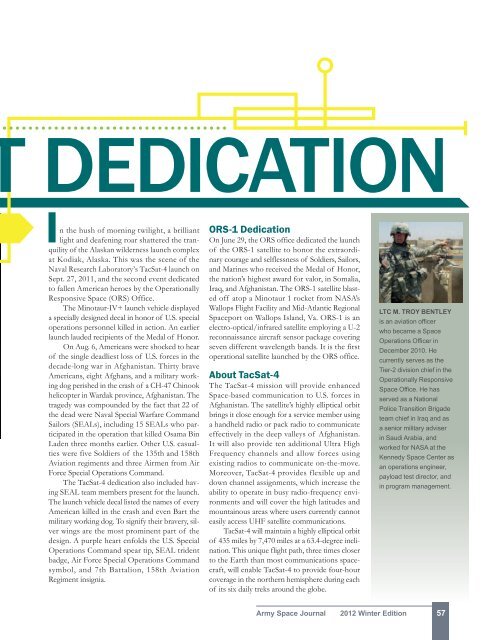2012 Winter - Space and Missile Defense Command - U.S. Army
2012 Winter - Space and Missile Defense Command - U.S. Army
2012 Winter - Space and Missile Defense Command - U.S. Army
Create successful ePaper yourself
Turn your PDF publications into a flip-book with our unique Google optimized e-Paper software.
dedICAtIoN<br />
In the hush of morning twilight, a brilliant<br />
light <strong>and</strong> deafening roar shattered the tranquility<br />
of the Alaskan wilderness launch complex<br />
at Kodiak, Alaska. This was the scene of the<br />
Naval Research Laboratory’s TacSat-4 launch on<br />
Sept. 27, 2011, <strong>and</strong> the second event dedicated<br />
to fallen American heroes by the Operationally<br />
Responsive <strong>Space</strong> (ORS) Office.<br />
The Minotaur-IV+ launch vehicle displayed<br />
a specially designed decal in honor of U.S. special<br />
operations personnel killed in action. An earlier<br />
launch lauded recipients of the Medal of Honor.<br />
On Aug. 6, Americans were shocked to hear<br />
of the single deadliest loss of U.S. forces in the<br />
decade-long war in Afghanistan. Thirty brave<br />
Americans, eight Afghans, <strong>and</strong> a military working<br />
dog perished in the crash of a CH-47 Chinook<br />
helicopter in Wardak province, Afghanistan. The<br />
tragedy was compounded by the fact that 22 of<br />
the dead were Naval Special Warfare Comm<strong>and</strong><br />
Sailors (SEALs), including 15 SEALs who participated<br />
in the operation that killed Osama Bin<br />
Laden three months earlier. Other U.S. casualties<br />
were five Soldiers of the 135th <strong>and</strong> 158th<br />
Aviation regiments <strong>and</strong> three Airmen from Air<br />
Force Special Operations Comm<strong>and</strong>.<br />
The TacSat-4 dedication also included having<br />
SEAL team members present for the launch.<br />
The launch vehicle decal listed the names of every<br />
American killed in the crash <strong>and</strong> even Bart the<br />
military working dog. To signify their bravery, silver<br />
wings are the most prominent part of the<br />
design. A purple heart enfolds the U.S. Special<br />
Operations Comm<strong>and</strong> spear tip, SEAL trident<br />
badge, Air Force Special Operations Comm<strong>and</strong><br />
symbol, <strong>and</strong> 7th Battalion, 158th Aviation<br />
Regiment insignia.<br />
ORS-1 Dedication<br />
On June 29, the ORS office dedicated the launch<br />
of the ORS-1 satellite to honor the extraordinary<br />
courage <strong>and</strong> selflessness of Soldiers, Sailors,<br />
<strong>and</strong> Marines who received the Medal of Honor,<br />
the nation’s highest award for valor, in Somalia,<br />
Iraq, <strong>and</strong> Afghanistan. The ORS-1 satellite blasted<br />
off atop a Minotaur 1 rocket from NASA’s<br />
Wallops Flight Facility <strong>and</strong> Mid-Atlantic Regional<br />
<strong>Space</strong>port on Wallops Isl<strong>and</strong>, Va. ORS-1 is an<br />
electro-optical/infrared satellite employing a U-2<br />
reconnaissance aircraft sensor package covering<br />
seven different wavelength b<strong>and</strong>s. It is the first<br />
operational satellite launched by the ORS office.<br />
About TacSat-4<br />
The TacSat-4 mission will provide enhanced<br />
<strong>Space</strong>-based communication to U.S. forces in<br />
Afghanistan. The satellite’s highly elliptical orbit<br />
brings it close enough for a service member using<br />
a h<strong>and</strong>held radio or pack radio to communicate<br />
effectively in the deep valleys of Afghanistan.<br />
It will also provide ten additional Ultra High<br />
Frequency channels <strong>and</strong> allow forces using<br />
existing radios to communicate on-the-move.<br />
Moreover, TacSat-4 provides flexible up <strong>and</strong><br />
down channel assignments, which increase the<br />
ability to operate in busy radio-frequency environments<br />
<strong>and</strong> will cover the high latitudes <strong>and</strong><br />
mountainous areas where users currently cannot<br />
easily access UHF satellite communications.<br />
TacSat-4 will maintain a highly elliptical orbit<br />
of 435 miles by 7,470 miles at a 63.4-degree inclination.<br />
This unique flight path, three times closer<br />
to the Earth than most communications spacecraft,<br />
will enable TacSat-4 to provide four-hour<br />
coverage in the northern hemisphere during each<br />
of its six daily treks around the globe.<br />
LtC M. trOY BentLeY<br />
is an aviation officer<br />
who became a <strong>Space</strong><br />
Operations Officer in<br />
December 2010. He<br />
currently serves as the<br />
Tier-2 division chief in the<br />
Operationally Responsive<br />
<strong>Space</strong> Office. He has<br />
served as a National<br />
Police Transition Brigade<br />
team chief in Iraq <strong>and</strong> as<br />
a senior military adviser<br />
in Saudi Arabia, <strong>and</strong><br />
worked for NASA at the<br />
Kennedy <strong>Space</strong> Center as<br />
an operations engineer,<br />
payload test director, <strong>and</strong><br />
in program management.<br />
<strong>Army</strong> <strong>Space</strong> Journal <strong>2012</strong> <strong>Winter</strong> edition 57
















